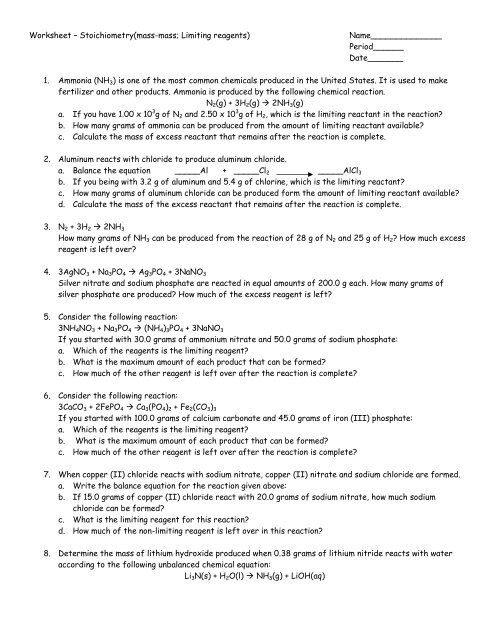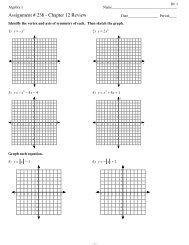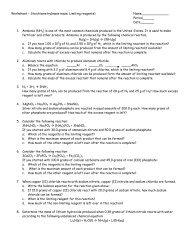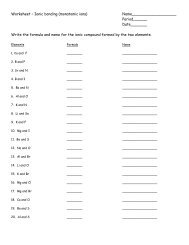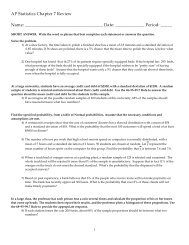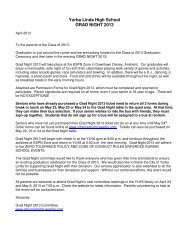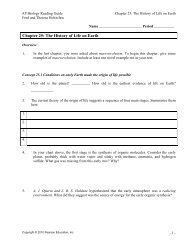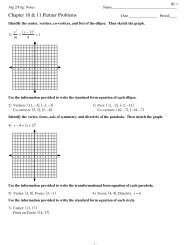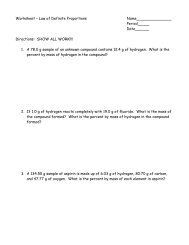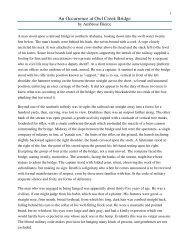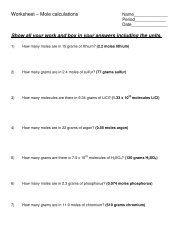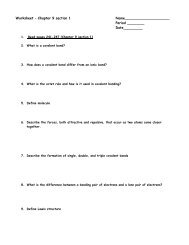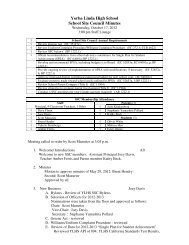Worksheet – Stoichiometry(mass-mass; Limiting reagents ...
Worksheet – Stoichiometry(mass-mass; Limiting reagents ...
Worksheet – Stoichiometry(mass-mass; Limiting reagents ...
You also want an ePaper? Increase the reach of your titles
YUMPU automatically turns print PDFs into web optimized ePapers that Google loves.
<strong>Worksheet</strong> <strong>–</strong> <strong>Stoichiometry</strong>(<strong>mass</strong>-<strong>mass</strong>; <strong>Limiting</strong> <strong>reagents</strong>)Name______________Period______Date_______1. Ammonia (NH 3 ) is one of the most common chemicals produced in the United States. It is used to makefertilizer and other products. Ammonia is produced by the following chemical reaction.N 2 (g) + 3H 2 (g) 2NH 3 (g)a. If you have 1.00 x 10 3 g of N 2 and 2.50 x 10 3 g of H 2 , which is the limiting reactant in the reaction?b. How many grams of ammonia can be produced from the amount of limiting reactant available?c. Calculate the <strong>mass</strong> of excess reactant that remains after the reaction is complete.2. Aluminum reacts with chloride to produce aluminum chloride.a. Balance the equation _____Al + _____Cl 2 _____AlCl 3b. If you being with 3.2 g of aluminum and 5.4 g of chlorine, which is the limiting reactant?c. How many grams of aluminum chloride can be produced form the amount of limiting reactant available?d. Calculate the <strong>mass</strong> of the excess reactant that remains after the reaction is complete.3. N 2 + 3H 2 2NH 3How many grams of NH 3 can be produced from the reaction of 28 g of N 2 and 25 g of H 2 ? How much excessreagent is left over?4. 3AgNO 3 + Na 3 PO 4 Ag 3 PO 4 + 3NaNO 3Silver nitrate and sodium phosphate are reacted in equal amounts of 200.0 g each. How many grams ofsilver phosphate are produced? How much of the excess reagent is left?5. Consider the following reaction:3NH 4 NO 3 + Na 3 PO 4 (NH 4 ) 3 PO 4 + 3NaNO 3If you started with 30.0 grams of ammonium nitrate and 50.0 grams of sodium phosphate:a. Which of the <strong>reagents</strong> is the limiting reagent?b. What is the maximum amount of each product that can be formed?c. How much of the other reagent is left over after the reaction is complete?6. Consider the following reaction:3CaCO 3 + 2FePO 4 Ca 3 (PO 4 ) 2 + Fe 2 (CO 3 ) 3If you started with 100.0 grams of calcium carbonate and 45.0 grams of iron (III) phosphate:a. Which of the <strong>reagents</strong> is the limiting reagent?b. What is the maximum amount of each product that can be formed?c. How much of the other reagent is left over after the reaction is complete?7. When copper (II) chloride reacts with sodium nitrate, copper (II) nitrate and sodium chloride are formed.a. Write the balance equation for the reaction given above:b. If 15.0 grams of copper (II) chloride react with 20.0 grams of sodium nitrate, how much sodiumchloride can be formed?c. What is the limiting reagent for this reaction?d. How much of the non-limiting reagent is left over in this reaction?8. Determine the <strong>mass</strong> of lithium hydroxide produced when 0.38 grams of lithium nitride reacts with wateraccording to the following unbalanced chemical equation:Li 3 N(s) + H 2 O(l) NH 3 (g) + LiOH(aq)


